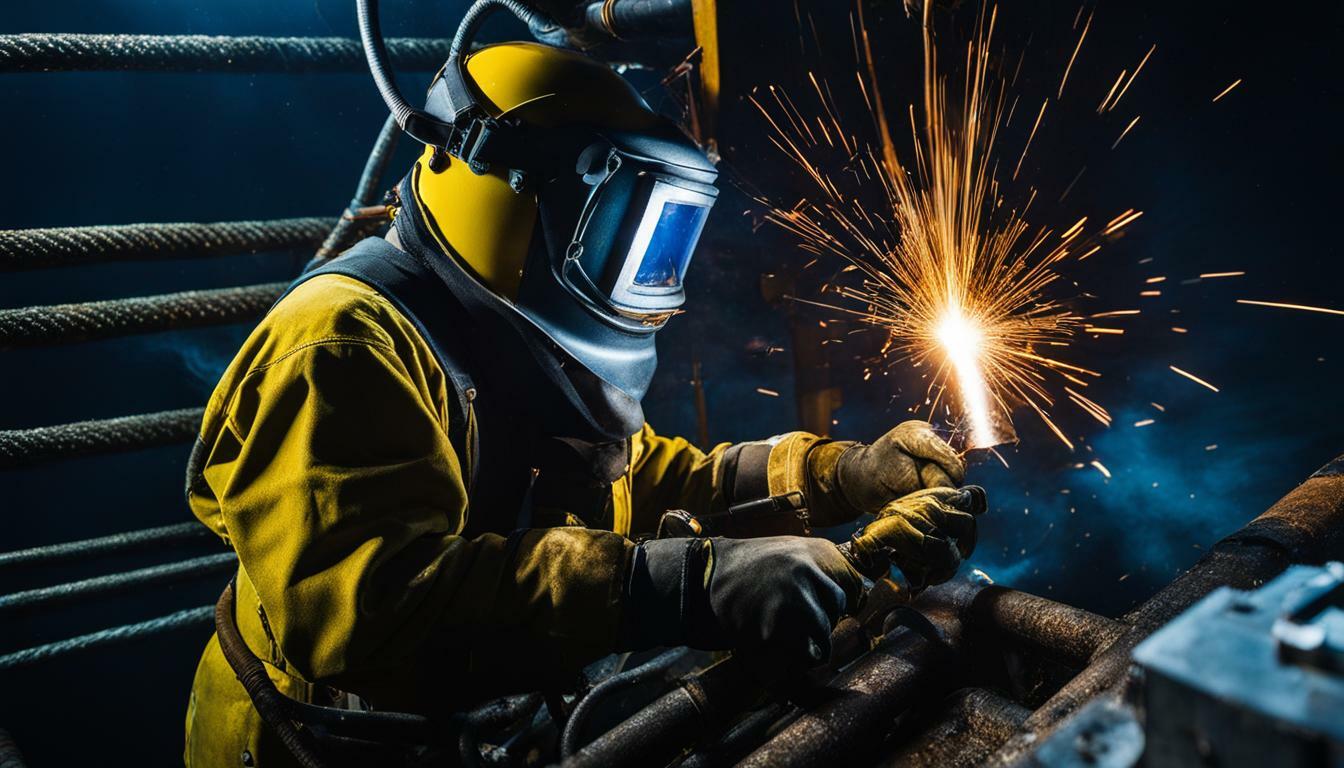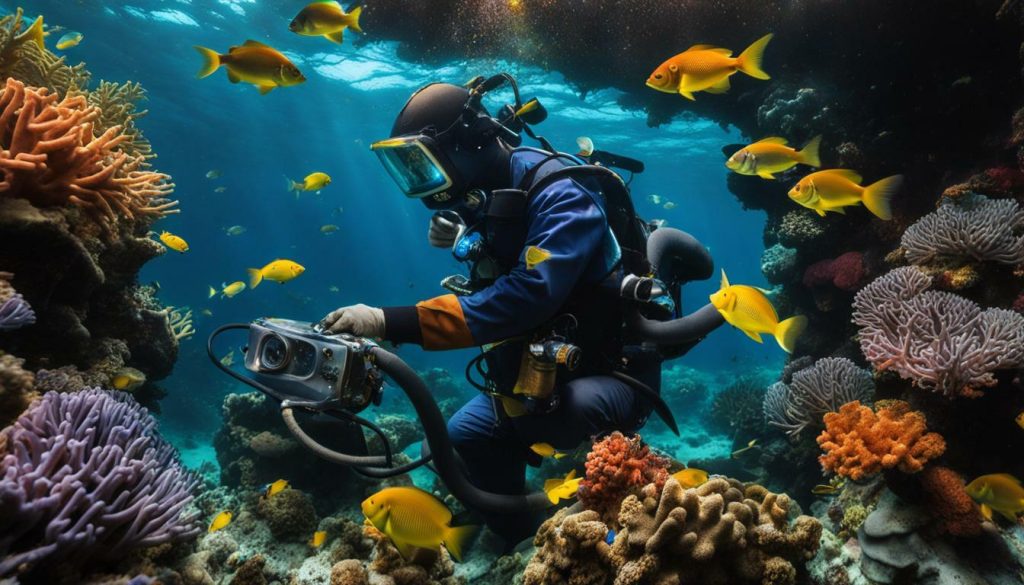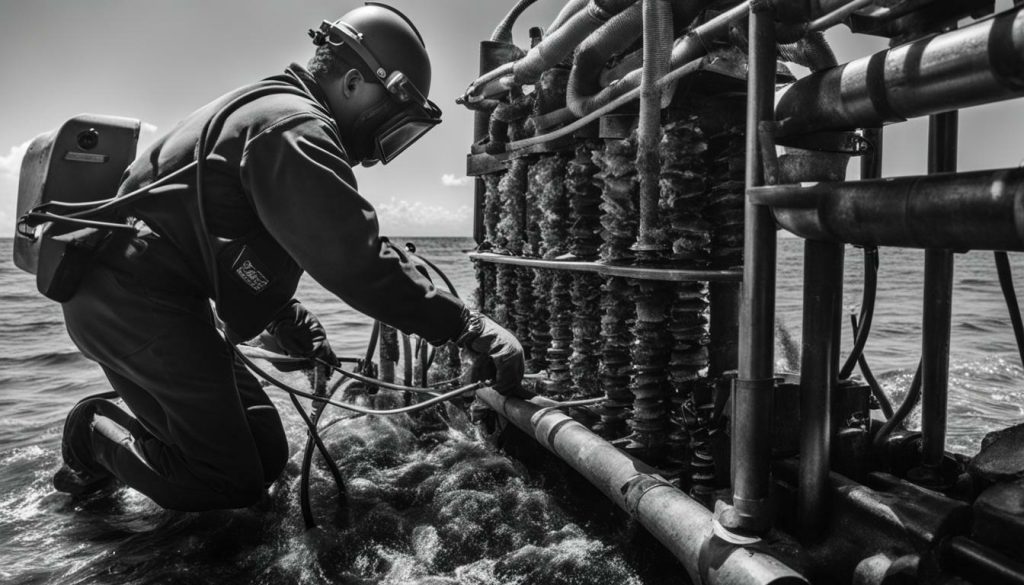
Welcome to the world of underwater welder skill development, where we will explore the techniques and training needed to excel in this unique profession.
- Underwater welding requires both diving and welding skills.
- Techniques like arc welding and hyperbaric welding are used in underwater welding.
- Training and certification are necessary to become an underwater welder.
- Additional skills like cutting, fitting, rigging, and inspection can enhance a welder-diver’s qualifications.
- Career opportunities include roles as engineers, instructors, supervisors, superintendents, and consultants.
- Safety precautions like proper venting and wearing appropriate gear are essential in underwater welding.
- Specialized training leads to improved employability and job security in the field.
Underwater welding is a specialized skill that involves performing welding tasks in a wet environment. Underwater welders need to be skilled divers as well as skilled welders. There are various techniques used in underwater welding, including arc welding and hyperbaric welding. Training in both welding and diving is required to become an underwater welder, and certification tests must be passed. The demand for underwater welders is increasing due to the need for maintenance and repair work on underwater pipelines, ships, and oil platforms. The pay for underwater welders can vary widely depending on the complexity and danger of the job, with the potential to earn over $100,000 per year. Additional skills such as underwater cutting, fitting and rigging, inspection and nondestructive testing, drafting, and underwater photography are recommended to supplement the qualifications of a welder-diver. Experienced welder-divers can pursue career opportunities as engineers, instructors, diving operation supervisors, superintendents, or consultants. Safety precautions must be taken when working underwater, including proper venting of gases and wearing the appropriate dive gear and welding protective equipment. Specialized training is necessary to become a certified underwater welder. The rewards of becoming an underwater welder include improved employability, job security, and the personal satisfaction of completing challenging tasks.
The Basics of Underwater Welding
Before diving into the depths, let’s familiarize ourselves with the basics of underwater welding and the techniques used in this specialized field. Underwater welding is a challenging profession that requires a unique set of skills. It involves performing welding tasks in a wet environment, which presents various complications and risks.
There are different techniques employed in underwater welding, and two of the most commonly used ones are arc welding and hyperbaric welding. Arc welding, also known as stick welding, is a widely utilized method that involves creating an electrical arc between the welding rod and the workpiece, generating intense heat to melt the metal and form a weld. Hyperbaric welding, on the other hand, is a specialized technique that takes place in a pressurized chamber. This method allows welders to work at depths greater than 150 feet, as the chamber provides a controlled environment for welding. It is particularly suitable for projects involving deep-sea infrastructure repairs.
Underwater welding requires a combination of welding and diving skills. This means that aspiring underwater welders must undergo comprehensive training in both disciplines. They need to be proficient in welding techniques and possess a thorough understanding of the principles of diving, including underwater communication, navigation, and safety procedures. Certification tests must be passed to become a recognized underwater welder, ensuring that divers have the necessary knowledge and practical skills to perform their duties safely and effectively.
| Technique | Description |
|---|---|
| Arc Welding | A method involving the creation of an electrical arc between the welding rod and the workpiece to generate intense heat for welding. |
| Hyperbaric Welding | A specialized technique performed in a pressurized chamber, enabling welding at depths greater than 150 feet. |
As the demand for maintenance and repair work on underwater pipelines, ships, and oil platforms continues to grow, so does the need for skilled underwater welders. This presents lucrative employment opportunities for individuals with the right qualifications. Depending on the complexity and danger of the job, underwater welders can earn over $100,000 per year. To enhance their employability and increase the range of projects they can undertake, welder-divers are advised to develop additional skills such as underwater cutting, fitting and rigging, inspection and nondestructive testing, drafting, and underwater photography.
Experienced welder-divers have the potential to advance their careers in various directions. They can pursue opportunities as engineers, instructors, diving operation supervisors, superintendents, or consultants. These roles allow them to apply their expertise in leadership positions, contribute to the development of specialized projects, and provide guidance to aspiring welder-divers.

Safety is paramount in underwater welding due to the unique challenges posed by the underwater environment. Proper venting of gases is essential to ensure a safe work environment, and divers must wear the appropriate dive gear and welding protective equipment. Precautions must also be taken to minimize the risk of decompression sickness and other potential health hazards associated with working in pressurized conditions. Specialized training is necessary to become a certified underwater welder, as it equips divers with the knowledge and skills needed to handle these risks and maintain safety while performing their tasks.
In conclusion, underwater welding is a highly specialized field that requires a combination of welding and diving skills. By acquiring the necessary training and certifications, divers can embark on a rewarding career with diverse opportunities. While safety precautions are crucial, the rewards of becoming an underwater welder include improved employability, job security, and the personal satisfaction of completing challenging tasks in unique and demanding environments.
Becoming a Certified Underwater Welder
If you’re ready to take the plunge into a career as an underwater welder, it’s important to understand the path to certification and the training requirements involved. Becoming a certified underwater welder requires specialized training in both welding and diving, as well as passing certification tests.
Training programs for underwater welding are typically offered by technical schools, vocational training centers, or diving schools. These programs provide a comprehensive curriculum that covers the fundamentals of welding and the specific challenges faced in underwater environments. Students learn various welding techniques, including arc welding and hyperbaric welding.
Once the training program is completed, aspiring underwater welders must pass certification tests to demonstrate their competence in the field. These tests typically involve a combination of written exams and practical assessments. The certification process ensures that underwater welders possess the necessary knowledge and skills to work safely and effectively in the demanding underwater environment.

Obtaining certification as an underwater welder can open up numerous opportunities for career advancement. Certified welder-divers are in high demand for maintenance and repair work on underwater pipelines, ships, and oil platforms. The pay for underwater welders can vary widely depending on the complexity and danger of the job, with the potential to earn over $100,000 per year.
Training Requirements for Underwater Welder Certification
The specific training requirements for underwater welder certification may vary depending on the country or governing body. However, most certification programs require a combination of diving and welding training. Aspiring underwater welders must complete a minimum number of training hours in both disciplines.
| Training Requirements | Hours |
|---|---|
| Welding Training | At least 800 hours |
| Diving Training | At least 300 hours |
These training requirements ensure that underwater welders have a solid foundation in both welding techniques and diving skills. It is important to note that the training hours specified above are a minimum requirement, and additional training may be necessary depending on the certification program and specific job requirements.
Expanding Your Skillset
To truly excel as an underwater welder, it’s beneficial to expand your skillset beyond welding and diving techniques. Developing additional skills not only enhances your capabilities as a welder-diver but also increases your employability and opens up new career opportunities.
One important skill for an underwater welder is underwater cutting. This involves using specialized equipment to cut through metal underwater, allowing for repairs and modifications to be made. Understanding cutting techniques and having the ability to effectively use cutting tools is crucial for a welder-diver.
Another valuable skill is fitting and rigging. Underwater welders often need to install and secure metal structures or components, requiring knowledge of rigging techniques and the ability to properly fit and align various parts. This skill is essential for completing complex underwater welding projects effectively and safely.
Inspection and nondestructive testing is another skill that can greatly benefit a welder-diver. Being able to assess the integrity of underwater structures, identify potential issues, and conduct tests to detect flaws or defects is essential for ensuring the safety and reliability of welded connections.

In addition to technical skills, having drafting skills can be advantageous. Being able to read and interpret technical drawings and blueprints allows welder-divers to understand project requirements and execute their work with precision. This skill is particularly important when working on complex underwater welding projects.
Lastly, having knowledge of underwater photography can be beneficial for documenting work progress, capturing images of welded joints, and providing visual evidence of completed projects. Underwater photography skills can also be valuable for inspecting underwater structures for any signs of deterioration or damage.
By expanding your skillset to include underwater cutting, fitting and rigging, inspection and nondestructive testing, drafting, and underwater photography, you can position yourself as a highly qualified and sought-after underwater welder. These skills not only enhance your capabilities but also open up doors to a variety of career opportunities within the field.
Advancing Your Career as a Welder-Diver
Once you’ve gained experience as a welder-diver, a whole world of career opportunities opens up, allowing you to further advance in this specialized field. With your unique set of skills and expertise, you can explore various paths that offer both professional growth and personal fulfillment.
One option is to become an engineer, where you can use your knowledge of welding and diving to design and oversee complex underwater projects. Engineers play a crucial role in ensuring the safety and efficiency of underwater operations, making this career path a perfect fit for welder-divers who enjoy problem-solving and want to make a significant impact.
If teaching and sharing your expertise is something that appeals to you, consider becoming an instructor. As a certified underwater welding instructor, you can train and mentor aspiring welder-divers, passing on your knowledge and skills to the next generation. This rewarding role allows you to contribute to the growth of the industry and help others succeed.
For those with leadership qualities, becoming a diving operation supervisor or superintendent might be the right path. In these positions, you will oversee and coordinate underwater welding projects, ensuring that everything runs smoothly and safely. You’ll be responsible for managing teams, budgets, and timelines, allowing you to showcase your organizational and managerial skills.
Another avenue to consider is becoming a consultant. As a consultant, you can provide expert advice and guidance to clients in need of underwater welding services. Your extensive experience and technical knowledge will be highly sought after, offering you the flexibility to work on a variety of projects and collaborate with different organizations.
Remember that the advancement of your career as a welder-diver is not limited to these options alone. The field of underwater welding continues to evolve, presenting new opportunities and challenges. By staying updated on industry trends and expanding your skillset, you can carve out a successful and fulfilling career in this specialized field.
| Opportunity | Description |
|---|---|
| Engineer | Design and oversee complex underwater projects |
| Instructor | Train and mentor aspiring welder-divers |
| Diving Operation Supervisor | Oversee and coordinate underwater welding projects |
| Superintendent | Manage teams, budgets, and timelines for underwater projects |
| Consultant | Provide expert advice and guidance to clients |
Ensuring Safety in Underwater Welding
Safety is paramount when working underwater as a welder, and understanding and implementing the necessary precautions is vital for a successful and secure career. As an underwater welder, you will be faced with unique challenges and potential risks that require careful attention and preparation. Here are some key safety precautions to consider when engaging in underwater welding:
First and foremost, proper venting of gases is crucial to prevent the build-up of hazardous fumes. When welding underwater, the surrounding water pressure can cause gases to behave differently than in an above-water welding environment. It is essential to ensure that adequate ventilation is in place to remove potentially harmful gases and maintain a safe working environment.
Additionally, wearing the appropriate dive gear and welding protective equipment is essential for personal safety. This includes a reliable diving suit, helmet, and gloves, as well as specialized welding gear designed to withstand the unique conditions encountered underwater. Investing in high-quality, industry-approved equipment is crucial to protect yourself from potential risks and ensure optimal safety throughout the welding process.
Specialized training is necessary to become a certified underwater welder and acquire the skills needed to handle potential risks effectively. Through comprehensive training programs, you will learn the proper techniques and safety protocols specific to underwater welding. By staying updated with the latest safety guidelines and regulations, you can remain at the forefront of industry best practices and maintain a secure work environment.
By prioritizing safety in underwater welding, you can mitigate risks, protect yourself, and enhance your career prospects. The rewards of becoming an underwater welder are numerous, including improved employability, job security, and the personal satisfaction of completing challenging tasks. Safeguard your future by embracing safety precautions as an integral part of your underwater welding journey.
FAQ
What is underwater welding?
Underwater welding is a specialized skill that involves performing welding tasks in a wet environment. It requires both diving and welding expertise.
What techniques are used in underwater welding?
The techniques used in underwater welding include arc welding and hyperbaric welding, among others.
What training is required to become an underwater welder?
To become an underwater welder, you must undergo training in both welding and diving. Certification tests must also be passed.
Why is additional skill development important for underwater welders?
In addition to welding and diving skills, it is recommended for underwater welders to gain expertise in underwater cutting, fitting and rigging, inspection and nondestructive testing, drafting, and underwater photography.
What career opportunities are available for experienced welder-divers?
Experienced welder-divers can pursue career opportunities as engineers, instructors, diving operation supervisors, superintendents, or consultants.
What safety precautions should be taken in underwater welding?
Safety precautions in underwater welding include proper venting of gases and wearing the appropriate dive gear and welding protective equipment.



